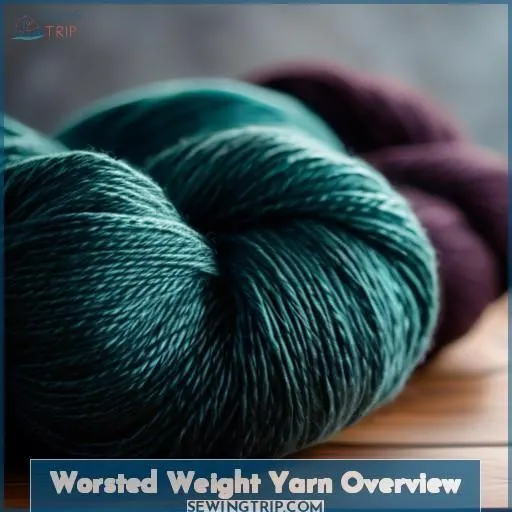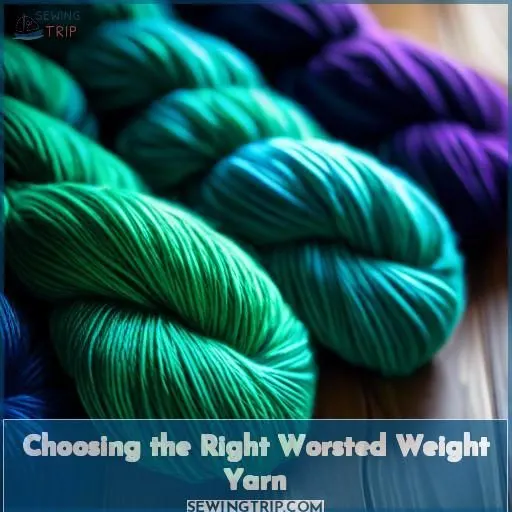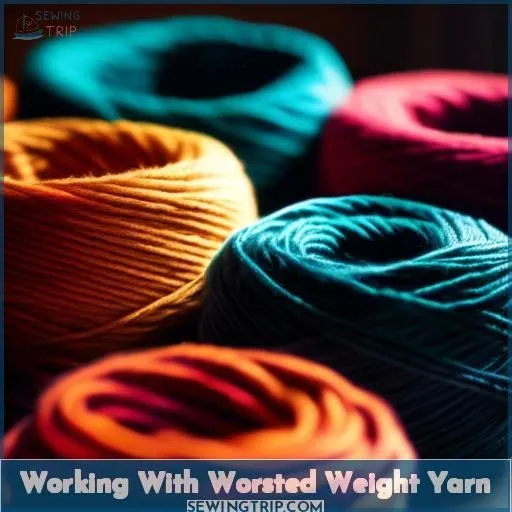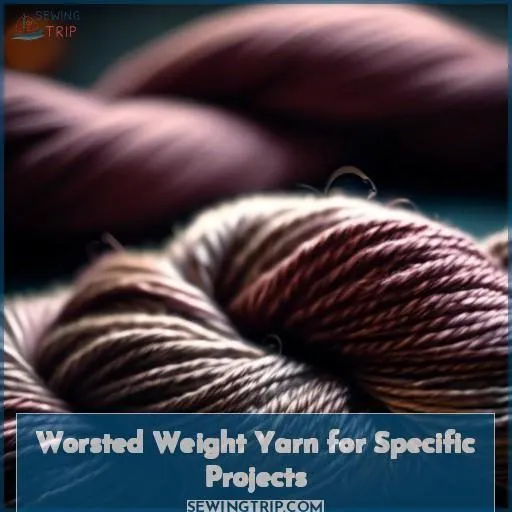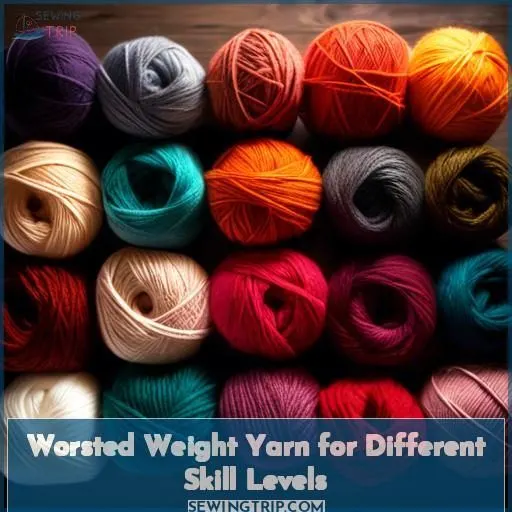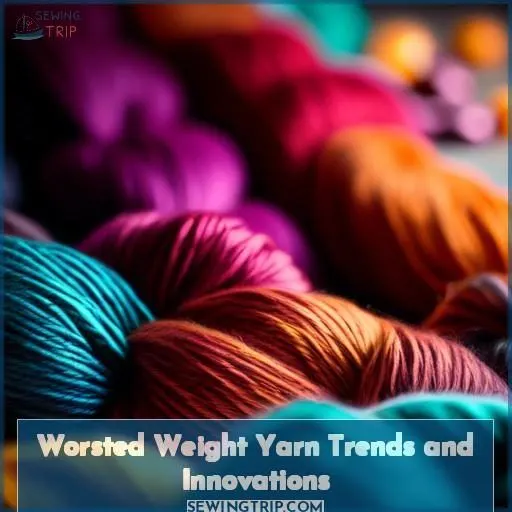This site is supported by our readers. We may earn a commission, at no cost to you, if you purchase through links.
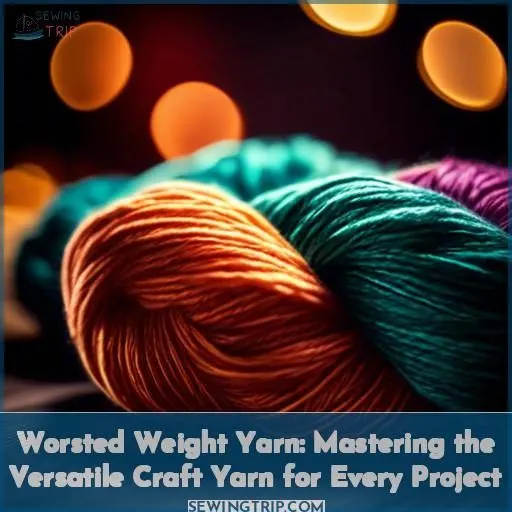
You’re wise to explore worsted weight yarn – it’s the most versatile option for knitters and crocheters.
This medium-weight, #4 CYC yarn is crafted from wool, cotton, acrylic, or blends. Its gauge of 3-4 stitches per inch makes it perfect for sweaters, blankets, accessories, and more.
Factors like fiber content, quality, and intended use determine which worsted weight yarn suits your project best.
Familiarize yourself with gauge, tension, and techniques needed to work with this yarn.
Mastering worsted weight yarn’s nuances guarantees your creations turn out beautifully – and you’ll gain insights to advance your skills further.
Table Of Contents
Key Takeaways
- Worsted weight yarn is a versatile, medium-weight yarn classified as number four by the Craft Yarn Council, suitable for a wide range of knitting and crocheting projects, including sweaters, hats, scarves, and blankets.
- It is available in various materials such as wool, cotton, acrylic, and blends, offering options for different preferences, projects, and price points.
- The number of plies in worsted weight yarn can affect its thickness, strength, and durability, with more plies reducing pilling and breakage.
- When selecting worsted weight yarn for a project, consider factors such as fiber content, yarn quality and durability, intended use, and care instructions to ensure the best results.
Worsted Weight Yarn Overview
Worsted weight yarn, a medium-weight yarn classified as #4 on the standardized Craft Yarn Council system, is the most popular and versatile yarn for knitting and crocheting projects. As an all-purpose yarn suitable for sweaters, blankets, accessories, and more, it’s available in various materials like wool, cotton, acrylic, and blends, with prices ranging from budget-friendly to luxury.
Definition and Classification
Worsted weight yarn is a medium weight yarn that falls between light and bulky yarns. It’s classified as a medium weight number four yarn in the Craft Yarn Council’s standardized yarn weight system. The knitting gauge for worsted yarn is typically 16-20 stitches per four inches of knitting, and it’s suitable for various projects such as knitting sweaters, hats, scarves, mittens, blankets, and more.
Worsted yarn is available in different plies, with single-ply yarn being the thinnest and most lightweight, and four-ply yarn being the thickest and most robust. The number of plies determines the thickness and strength of the yarn, with more plies reducing pilling and breakage.
When choosing a worsted weight yarn, consider factors such as yarn quality and durability, fiber content and allergies, yarn weight and gauge, and yarn care and maintenance. Some popular worsted weight yarn brands include KnitPicks, WeCrochet, Lion Brand, and LoveCrafts.
Worsted weight yarn is priced between $1.20 and $24.99 per skein or hank, with discounts and sales available. The price can vary based on the weight, material, and brand of the yarn.
Worsted weight yarn is commonly used for knitting and crochet projects, and is suitable for beginners and experienced crafters alike. It’s available in various materials such as cotton, acrylic, wool, alpaca, and blends, and can be used for a wide range of projects.
Characteristics and Uses
Welcome to the realm of worsted weight yarn! This adaptable yarn is ideal for a vast array of projects, from knitting sweaters and hats to crocheting scarves and blankets. Let’s explore the properties and applications of worsted weight yarn.
- History and Alternatives: Worsted weight yarn has a rich history, with its name stemming from the English town of Worstead, renowned for its wool production. It’s a favored choice for many crafters, often interchanged with yarns of comparable weight, such as aran weight or bulky yarn.
- Color Palettes and Storage: Worsted weight yarn is available in a spectrum of colors, making it appropriate for a multitude of projects. When storing your yarn, it’s crucial to shield it from direct sunlight and extreme temperatures to preserve its quality.
- Dyeing and Uses: Worsted weight yarn is amenable to various dyeing techniques, including hand-dyeing or dyeing with a dye pot. It’s utilized in a variety of applications, including garments, accessories, home décor, and even in sewing and quilting.
- Versatility and Comparison: As a medium weight yarn, worsted weight yarn is thicker than sock and sport weight yarns but thinner than bulky yarn. It’s often regarded as a multipurpose yarn, suitable for a wide range of projects.
Worsted weight yarn is truly a versatile craft yarn that can be employed for a multitude of projects. Whether you’re a novice or a seasoned crafter, this yarn weight presents a vast array of possibilities for your creative endeavors.
Yarn Weight System
Understanding the yarn weight system is essential for knitters and crocheters.
Medium weight yarn, classified as worsted weight, is appropriate for various projects such as sweaters, hats, and blankets.
Look for the number four on the yarn label or the word worsted.
Needle size varies depending on the project, and yarn tension should be adjusted to achieve the desired gauge.
Yarn labeling, storage, winding, dyeing, and tension are all factors to keep in mind when working with worsted weight yarn.
Yarn Materials and Applications
Immerse yourself in yarn spinning and dyeing; it’s the foundation of crafting with worsted weight yarn. Investigate materials, applications, and storage for limitless project inspiration.
Yarn Weight Comparison
Yarn weight comparison is a vital aspect of choosing the right yarn for your project. Understanding the differences between yarn weights can help you make informed decisions when selecting yarn substitutes or comparing fiber types. Here’s a 4-item numeric list to help you grasp the concept:
- Yarn Weight System: The Craft Yarn Council (CYC) standardized yarn weight system classifies yarns from lightest to heaviest: thread, cobweb, lace, light fingering, fingering, sport, DK, worsted, Aran, bulky, super bulky, and jumbo.
- Gauge Comparisons: Worsted weight yarn typically achieves a gauge of 3-4 stitches per inch, while sport weight yarn has a gauge of 5-6 stitches per inch. DK weight yarn has a gauge of 4-5 stitches per inch, and bulky weight yarn has a gauge of 3-3.5 stitches per inch.
- Project Suitability: Worsted weight yarn is ideal for knitting sweaters, hats, scarves, mittens, and blankets, while sport weight yarn is suitable for lightweight garments and accessories. DK weight yarn is commonly used for light hats, gloves, and shawls, and bulky weight yarn is ideal for large projects like scarves, accessories, and blankets.
- Fiber Comparisons: Different fibers have varying densities, which affects the weight of yarns made from them. For example, cotton is more dense and weighs more than wool, even though the Worsted-weight cotton yarn is ‘heavier’ than Sport-weight wool.
Yarn Craft Types
Explore the diverse crafts that can be achieved with Worsted Weight Yarn! From knitting to crochet, this versatile yarn is perfect for garments, accessories, and home décor. Discover the endless possibilities and choose the right yarn for your project.
Yarn Weight Prices and Availability
Regarding yarn affordability, you have numerous avenues to acquire worsted weight yarn. Online marketplaces akin to Amazon proffer a spectrum of worsted weight yarns, with prices initiating at $4.99 per skein and escalating to $29.99 for superior options. Furthermore, one can encounter yarn clearances and discounts, with certain brands proffering up to 44% off their wholesale yarns. Local yarn emporiums can likewise be a valuable resource for discovering worsted weight yarn, as they frequently stock a diverse array of brands and materials.
Should you seek bulk savings, contemplate procuring yarn in more substantial quantities. For instance, Amazon offers a promotion wherein you can expend $100 to obtain complimentary shipping. Websites analogous to LoveCrafts and Row House Yarn additionally possess curated assortments of worsted weight yarn, with prices wavering from $5 to $37 per skein.
When purchasing worsted weight yarn, bear in mind that prices may fluctuate contingent upon the material, weight, and brand. For example, yarns composed entirely of wool may incur a higher cost than acrylic or cotton yarns, and premium blends or hand-dyed yarns will generally command a higher price than standard options.
Choosing the Right Worsted Weight Yarn
When choosing the perfect worsted weight yarn for your project, you’ll want to give careful thought to elements like fiber composition, weight, gauge, quality, and care instructions. The best option will hinge on the intended purpose, your skill level, desired drape, and any allergies or sensitivities – making an informed choice is vital to achieving the best results.
Factors to Consider
When choosing the right worsted weight yarn, consider these factors:
- Plying techniques: Worsted weight yarns come in various plies, from single-ply to eight-plies. More plies reduce pilling and breakage, making the yarn more durable.
- Yarn weight standards: The Craft Yarn Council (CYC) standardized yarn weight system classifies worsted yarn as a medium weight number four yarn.
- Regional variations: In the UK and Europe, worsted yarn is often referred to as Aran weight, while in North America, it’s typically called number four yarn.
- Dyeing methods: Worsted weight yarn is available in a wide range of colors, from solid shades to variegated patterns.
- Fiber blends: Worsted yarn is made from a variety of fibers, including wool, cotton, acrylic, and blends of natural and synthetic materials.
- Yarn care and maintenance: Consider the care instructions for the yarn, such as hand wash or machine wash, and the fiber content’s suitability for your project.
- Sourcing and buying worsted weight yarn: Look for yarns that are readily available in your area or online, and compare prices to find the best value.
- Tips for choosing the right worsted weight yarn: Consult yarn weight charts and guides, ask for recommendations from fellow crafters, and consider the specific needs of your project.
Yarn Quality and Durability
After considering factors, focus on yarn quality and durability. Compare brands, pricing, and substitutions. Cotlin DK and Alpaca Cloud DK exemplify worsted weight excellence.
Fiber Content and Allergies
When choosing the right worsted weight yarn, consider fiber content and allergies. Look for hypoallergenic options like cotton alternatives, wool blends, alpaca, or silk mohair. If you have fiber sensitivities, opt for single-ply yarns like Cascade 220 Superwash or Malabrigo Rios. Always read labels and consult with a healthcare professional if needed.
Yarn Weight and Gauge
To select the ideal worsted weight yarn, take into account yarn thickness, knitting methods, fiber combinations, and gauge variations. Project compatibility is paramount, as is the adaptability of worsted weight yarn, which can be utilized for a diverse array of projects. Bear in mind, the appropriate yarn weight and gauge guarantee a positive result.
Yarn Care and Maintenance
Proper yarn care is essential to preserve your worsted weight yarn’s quality. Store it correctly, remove stains promptly, blend fibers wisely, and dye techniques carefully.
Sourcing and Buying Worsted Weight Yarn
After mastering yarn care, delve into procuring worsted weight yarn. Embark on an exploration of local yarn emporiums, internet marketplaces, and bulk suppliers to find the ideal skein.
Tips for Choosing the Right Worsted Weight Yarn
Selecting the appropriate worsted weight yarn for your project is paramount to attaining the intended result. Here are some pointers to guide you in making the wisest choice:
- Fiber Comparison: Consider the yarn’s fiber composition and its impact on the final project. For example, wool provides warmth and insulation, while cotton offers breathability and ease of maintenance.
- Durability Assessment: Seek yarns with high tensile strength and elongation to guarantee the longevity of the finished product.
- Project Suitability: Choose a yarn that aligns with the gauge and needle size specified in the pattern. If the pattern indicates worsted weight yarn, opt for a yarn with a similar thickness.
- Gauge Considerations: Note that different yarns may have varying yardage per skein, which can affect the gauge and the number of skeins required for your project.
- Allergy Concerns: If you have allergies or sensitivities, select yarns made from hypoallergenic materials or those you’re confident in tolerating.
- Worsted Weight Yarn: Verify that the yarn you select is categorized as worsted weight, as this is the most prevalent weight for knitting and crochet.
- Versatile Craft Yarn: Worsted weight yarn is suited for a diverse range of projects, from apparel and accessories to home décor and amigurumi.
- Tips for Choosing: Adhere to a checklist that encompasses factors such as fiber content, construction, and gauge to make well-informed decisions.
Working With Worsted Weight Yarn
To work with worsted weight yarn effectively, you must choose suitable needles or hooks and understand proper gauge and tension. Mastering stitching techniques, following patterns accurately, troubleshooting common issues, exploring yarn substitutions, and personalizing your projects are essential for achieving desired results.
Needles and Hooks
Discover the perfect needles and hooks for your worsted weight yarn projects. Understand yarn gauges, tension control, needle compatibility, and hook selection for beginner-friendly patterns. Master the versatile craft yarn for every project.
Gauge and Tension
To make sure your worsted weight yarn projects come out flawlessly, it’s imperative to grasp gauge and tension. Gauge is the number of stitches and rows per inch, while tension refers to the tightness or looseness of your knitting. Swatching is a technique used to determine your knitting gauge, which is essential for choosing the right needle size and yarn for your project.
When working with worsted weight yarn, you’ll want to adjust your gauge to match the recommended gauge for the pattern. This may involve swapping out needles or using a different yarn if the gauge isn’t right. It’s also important to think about the yarn’s plies, as more plies can reduce pilling and breakage.
For gauge adjustment, you can use a variety of needles and hooks, depending on the project. Standard fabric typically requires a 4.5 to 5.5 mm (US 7-9) needle, while lace knitting may call for a 6.0 to 8.0 mm needle. For projects like socks, potholders, and dish towels, you’ll need a 3.25 to 4.0 mm needle. Always refer to the yarn label for recommended needle sizes.
To control tension, you can adjust your needle size up or down to achieve the desired knitting tension. Keep in mind that changing needle sizes will affect the final project’s size and drape.
When substituting yarns, remember that different yarns have different gauges, so you may need to adjust your needle size accordingly. It’s also essential to think about the yarn’s fiber content and any allergies you or the intended recipient may have.
Stitching Techniques
Explore a variety of knitting stitches and crochet stitches to master your worsted weight yarn. Practice yarn joins, tension control, and gauge swatches for the best results. Double-stranding and working with jumbo yarns can also improve your skills. Lace knitting and dish towels are great projects to practice these techniques.
Patterns and Projects
Explore yarn combinations with swish worsted and lanas by berroco, investigating stitch patterns, color combinations, texture, and embellishments like fyberspates cumulus.
Troubleshooting and Common Issues
When working with worsted weight yarn, some issues aren’t uncommon. Here are some common problems and solutions to aid in your knitting or crochet venture:
Yarn Tangles
Tangles can be frustrating, but they’re easily resolved. Simply untangle the yarn by gently pulling the strands apart and rewinding the ball or skein. If the yarn is particularly stubborn, try using a yarn comb or your fingers to detangle it.
Dropped Stitches
Dropped stitches can occur when you’re not paying close attention to your work. To fix this, you can use a needlepoint protector or tip ties to prevent stitches from slipping off your needles. If you’ve already dropped a stitch, you can use a crochet hook or a spare needle to weave the dropped stitch back into your work.
Yarn Weight Substitution
If you need to substitute a different yarn weight, it’s important to adjust your needle size and knit a swatch to determine the correct stitch count and gauge. This will help you achieve the desired look and fit for your project.
Pattern Adjustments
If you’re working with a pattern that doesn’t provide a breakdown of the stitch count, you can create a foundation chain and work the pattern using the yarn and crochet hook you intend to use. This will give you an idea of what the pattern will look like with the yarn.
Color Dimension
If you’re working with multiple colors, it’s important to maintain a consistent color pattern. You can use stitch markers or a crochet hook to mark the beginning of each color change.
Swish DK vs. Sandnes Garn
When working with different yarn brands like Swish DK and Sandnes Garn, you may need to adjust your needle size to achieve the correct stitch count and gauge. This will help you create a project that matches the intended pattern.
Mohair Effect
If you’re working with a yarn that has a mohair effect, you may need to adjust your needle size to accommodate the different texture. This will help you maintain the correct stitch count and gauge for your project.
City Tweed DK
When working with City Tweed DK, you may need to adjust your needle size to achieve the correct stitch count and gauge. This will help you create a project that matches the intended pattern.
Needle Size and Yarn Weight
Remember that different needle sizes and yarn weights can affect the number of stitches per inch and the overall size of your project. Adjusting both will help you achieve the desired look and fit for your project.
Stitching Techniques
When working with worsted weight yarn, it’s important to use the correct stitching techniques for your project. This includes using the appropriate needles or hooks and following the correct pattern instructions.
Patterns and Projects
If you’re having trouble with a specific pattern or project, consider seeking assistance from online resources or joining a knitting or crochet community. They can provide valuable advice and support to help you overcome any challenges you may encounter.
If you’re experiencing issues with your project, it’s important to address them promptly to prevent further complications. This may involve adjusting your needle size, yarn weight, or stitching techniques.
Yarn Substitutions and Alternatives
If you need to substitute a different yarn, it’s important to think about the fiber content, texture, and weight of the yarn. This will help you choose a suitable alternative that will work well with your project.
Personalizing Your Worsted Weight Yarn
To make your worsted weight yarn truly unique, consider experimenting with different colors, textures, and stitch patterns. This will help you create a project that reflects your personal style and preferences.
Yarn Substitutions and Alternatives
When you need a yarn substitution for your worsted weight project, consider twill aran or the little foxes. These yarns have equivalent weights and can be used as alternatives. Remember to adjust your needle size and gauge accordingly.
Personalizing Your Worsted Weight Yarn
To personalize your worsted weight yarn, you can explore various techniques such as dyeing and blending. Here are four ways to make your worsted weight yarn unique:
- Dyeing Worsted Yarn: You can dye your worsted weight yarn to achieve unique color combinations. For best results, use cotton or wool yarn and follow the dyeing instructions for your chosen yarn type. For synthetic yarn, you’ll need to use a dye specifically designed for synthetics.
- Yarn Blending: Blend different fibers together to create a custom yarn. This can be done by mixing fibers of different origins, length, thickness, or color before spinning. For example, you can blend wool and nylon to create a yarn that’s both warm and durable.
- Customizing Yarn Weight: You can also personalize your worsted weight yarn by adjusting the thickness and weight of the yarn. This can be done by changing the number of plies in the yarn, which affects the thickness and strength of the yarn.
- Creating Custom Color Palettes: By dyeing your worsted weight yarn in different colors and shades, you can create your own unique color palette. This can be done using various dyeing techniques, such as the twisted skein method, which allows the dye to penetrate the yarn unevenly, creating a variegated effect.
Worsted Weight Yarn for Specific Projects
Worsted weight yarn excels in versatility, ideal for tackling a wide array of projects. From knitting cozy sweaters and cardigans to crocheting intricate afghans and scarves, mastering this weight empowers you to craft hats, mittens, blankets, home decor, accessories, amigurumi, tapestry, and even quilting pieces with finesse.
Knitting Sweaters and Cardigans
Knit a cozy sweater or cardigan with worsted yarn. Follow gauge swatches for the perfect fit. Understand yarn weight conversion and choose fiber blends. Washing instructions are essential for care.
Crocheting Afghans and Scarves
Embark on crocheting afghans with vibrant color schemes and scarf texture that stands out. Select yarn thickness judiciously for the ideal afghan style and decorations.
Making Hats and Mittens
Master the art of hat-making and mitten crafting with worsted weight yarn. Explore various hat styles and mitten patterns, experiment with color combinations, and find seasonal inspiration. Discover the perfect yarn pairings for your projects, and let your creativity flow.
Creating Blankets and Pillows
Explore the art of creating cozy blankets and pillows with worsted weight yarn. Choose the right texture, color, and pattern for your project, considering sizing and decorative details. Embrace the versatility of this craft yarn and let your creativity shine.
Crafting Home Decor and Accessories
Crafting home decor and accessories with worsted weight yarn is a delightful process that allows you to showcase your creativity. Explore yarn dyeing, color mixing, embellishments, fabric manipulation, and pattern hacking to create unique pieces.
Designing Amigurumi and Tapestry
Unleash your imagination with medium-weight yarn! Create enchanting amigurumi toys using detailed patterns, or weave impressive tapestry pieces with distinctive textures and color combinations. Explore sources of inspiration for boundless opportunities.
Sewing and Quilting With Worsted Weight Yarn
After mastering amigurumi, transition into sewing and quilting with worsted weight yarn. Discover machine sewing and hand quilting methods utilizing vibrant yarn dyes and contemporary patterns.
Worsted Weight Yarn for Different Skill Levels
Worsted weight yarn offers knitters and crocheters of all skill levels a versatile and accessible medium to create a diverse range of projects. Whether you’re a beginner looking to start with simple garments and accessories or an advanced crafter tackling intricate stitch patterns and complex designs, worsted weight yarn provides the ideal balance of workability and durability.
Beginner Projects
As a beginner, start with worsted weight yarn for projects like scarves, mittens, blankets, hats, and socks. These projects are perfect for mastering the basics of knitting and crochet. Here are five beginner-friendly worsted weight projects:
- Worsted Weight Scarves: A great first project that allows you to practice stitching and finishing techniques.
- Worsted Weight Mittens: Learn to knit in the round and create a cozy pair of mittens.
- Worsted Weight Blankets: A larger project that teaches you to read patterns and work with larger needles.
- Worsted Weight Hats: A fun and quick project that helps you practice seaming and shaping.
- Worsted Weight Socks: A more advanced beginner project that teaches you to knit in the round and work with smaller needles.
Intermediate Projects
Intermediate projects with worsted weight yarn offer a balance between complexity and skill development. Choose yarns with unique characteristics for added challenge, consider yarn substitution for sustainability, and experiment with various stitching techniques.
Advanced Projects
Explore advanced techniques and complex stitches with worsted weight yarn. Intricate patterns and yarn manipulation add depth to your projects. Embellishments, such as beads or lace, elevate your work. Challenge yourself with advanced projects and enjoy the freedom of mastery.
Tips for Skill Development
After tackling advanced projects, focus on skill progression with worsted weight yarn through:
- Yarn experimentation to discover new textures
- Gauge customization for perfect fit
- Stitching exploration to broaden techniques
Community and Support for Worsted Weight Yarn Crafters
As a crafter, you understand the importance of community and support when working on your projects. Worsted weight yarn is a versatile and popular choice for knitters and crocheters, and there are numerous resources available to help you navigate your crafting journey. Here are some ways to connect with other crafters and find the support you need:
- Yarn swaps: Participate in local or online yarn swaps to trade and discover new yarns. These events can be a great way to meet fellow crafters and expand your yarn collection.
- Project sharing: Share your projects on social media or online forums to receive feedback and inspiration from others. You can also browse project galleries on websites like Ravelry to see what others have created with worsted weight yarn.
- Skill mentoring: Look for local knitting or crochet groups or clubs where you can learn from experienced crafters. Many cities have these groups, and they often welcome beginners.
- Online forums: Engage in online conversations on forums, blogs, or social media groups dedicated to knitting and crochet. These platforms provide a space for crafters to share tips, ask questions, and discuss their projects.
- Community events: Attend craft fairs, workshops, and other events where you can meet other crafters and learn new techniques. Some yarn companies even host community knitalongs or events to bring crafters together.
Worsted Weight Yarn Trends and Innovations
As the realm of yarn crafting advances, you’ll encounter novel worsted weight yarn materials like bamboo, milk protein fibers, and recycled plastic.
Anticipate technological strides too, with innovations in machine-knitting, applications of 3D printing, and intelligent yarn infused with conductive elements.
Ethical and sustainable sourcing gain momentum, making eco-friendly and fair-trade choices more widespread.
Collaborative projects between independent dyers, fiber artists, and renowned brands arise.
Additionally, yarn festivals, retreats, and trunk shows cater to the contemporary worsted weight yarn aficionado.
New Materials and Fibers
Explore the latest trends in worsted weight yarn with new dye techniques, novel yarn textures, sustainable yarn production, innovative yarn blends, and experimental yarn applications. Embrace the future of crafting with these exciting developments in the realm of worsted weight yarn.
Technological Advancements
As we weave through new materials, let’s unravel the thread of technological advancements in worsted weight yarn:
- Enhanced yarn spinning for superior texture
- Innovative dye techniques for vibrant colors
- Smart yarn management solutions for efficient storage and organization
Sustainable and Ethical Practices
Embrace your craft with a conscious: Discover the latest trends in worsted weight yarn, where sustainability and ethics take center stage. From sustainable sourcing to environmentally friendly dyes, learn how to make a difference with your choice of yarn. Support fair trade yarn and reduce your carbon footprint, all while mastering the art of knitting and crochet.
Collaborations and Partnerships
In the realm of worsted weight yarn, alliances and partnerships play a pivotal role in shaping the industry. Yarn purveyors, distributors, and retailers collaborate to provide superior yarns to artisans worldwide. Let’s delve into some key aspects of these collaborations:
- Yarn Purveyors: These entities procure the foundational materials for yarn, such as wool, cotton, or synthetic fibers. They work with farmers, shepherds, and other suppliers to obtain the finest raw materials for their products. Notable yarn purveyors include Lion Brand, Bernat, and Red Heart.
- Yarn Distributors: These companies acquire yarn from purveyors and distribute it to retailers. They may also offer ancillary services such as marketing, logistics, and quality control. Leading yarn distributors include WEBS, Darngoodyarn, and MadeinChina.
- Yarn Retailers: These establishments provide a platform for consumers to directly purchase yarn. They may operate online or in brick-and-mortar stores. Popular yarn retailers include WEBS, DHgate, and Etsy.
- Yarn Manufacturers: These companies transform raw materials into yarn and may also create finished products like knitting patterns or kits. Examples include Lion Brand, Bernat, and Red Heart.
- Yarn Wholesalers: These entities procure yarn in substantial quantities and distribute it to retailers at discounted prices. They may also offer additional services such as customized labeling or packaging. Prominent yarn wholesalers include DHgate and MadeinChina.
Collaborations between these entities can manifest in various forms, including co-branding, joint product development, or marketing partnerships. For instance, a yarn purveyor could align with a retailer to introduce a limited-edition yarn line, or a distributor could collaborate with a designer to develop a novel knitting pattern collection. These collaborations foster innovation, expand market reach, and provide a diverse array of products for artisans.
Events and Workshops
Worsted weight yarn is a versatile and popular choice for a wide range of knitting and crochet projects, from sweaters and hats to blankets and accessories. To fully explore the potential of worsted yarn, consider attending events and workshops that cater to knitters and crocheters. These events can provide inspiration, motivation, and hands-on learning opportunities to help you master the art of working with worsted weight yarn.
Some popular worsted weight yarn projects include:
- Sweaters: Worsted yarn creates a fabric with good drape and a nice, even stitch, making it perfect for sweaters.
- Scarves: Warm and cozy scarves can be crafted using worsted yarn.
- Hats: Worsted weight yarn is suitable for creating hats with a warm and comfortable fit.
- Blankets: Worsted yarn can be used to create blankets that are warm and cozy without being too heavy.
- Dishcloths: Worsted yarn is a popular choice for dishcloth knitting due to its durability and absorbency.
- Toys: Soft and cuddly toys can be made using worsted yarn.
- Mittens and gloves: Worsted weight yarn can be used to create mittens and gloves that are warm and comfortable to wear.
When attending events and workshops, you may have the opportunity to learn new techniques, meet fellow enthusiasts, and discover new yarn supplies and materials. These events can also serve as a platform for discussing the latest trends and innovations in the worsted yarn realm.
Frequently Asked Questions (FAQs)
What is the difference between worsted weight and bulky weight yarn?
Stare at a chunky cable-knit sweater, then picture a sleek worsted one. You’ll instantly grasp the difference – bulky’s hefty, while worsted’s thinner for refined drape. Master both weights to add textural diversity to your knitting game.
How do I determine the recommended needle size for worsted weight yarn?
Based on the yarn label, you’ll want to use a needle between 5-5mm (US 7-9) for standard worsted weight projects. Adjust as needed to achieve your desired fabric density.
Can worsted weight yarn be used for crochet projects?
Worsted weight yarn is a versatile choice for crochet projects. Its medium thickness makes it perfect for garments, accessories, and home decor like afghans and pillows. Just be sure to check the label for the recommended hook size.
How does the number of plies in worsted weight yarn affect its durability?
Did you know the number of plies in worsted weight yarn can make all the difference in its durability? More plies equal greater strength and reduced pilling – perfect for long-lasting garments and accessories.
Is worsted weight yarn suitable for making amigurumi or tapestry projects?
Absolutely, worsted weight yarn is a fantastic choice for amigurumi and tapestry projects. Its medium thickness and ample plies make it durable and well-suited for intricate stitchwork. Get creative and let your crafty side shine!
Conclusion
Unquestionably, worsted weight yarn forms the foundation of the knitting and crocheting realm. Its adaptability, resilience, and availability make it an optimal selection for artisans of all proficiencies.
By delving into the subtleties of this yarn, you’ll unveil a realm of imaginative prospects, from comfortable sweaters to elaborate home décor.
Embrace the capabilities of worsted weight yarn, and allow your vision to take flight as you create masterpieces that embody your distinctive style and craftsmanship.

